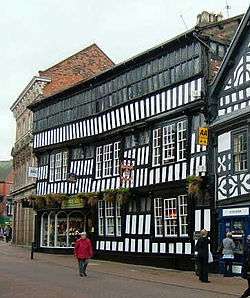Nantwich
| Nantwich | |
|---|---|
|
High Street | |
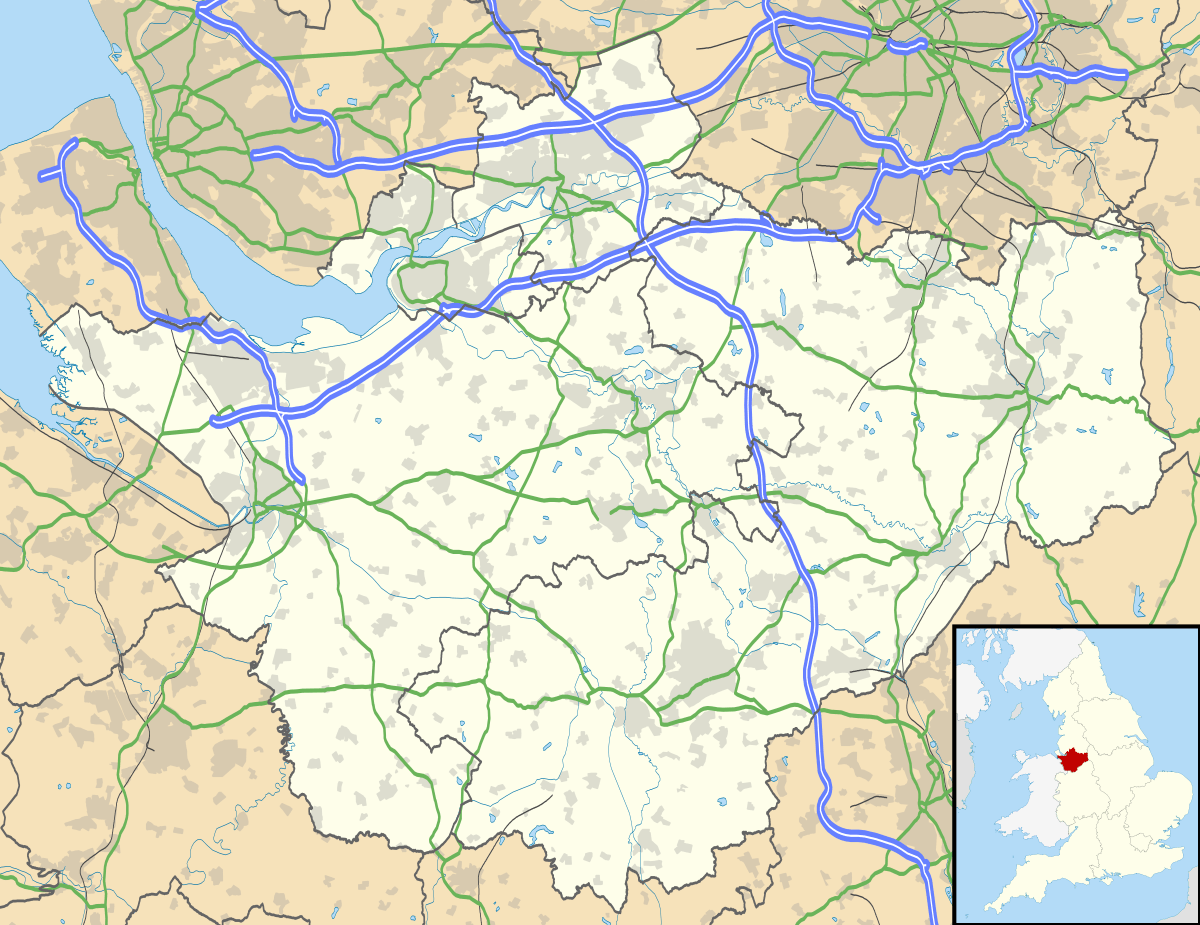 Nantwich Nantwich shown within Cheshire | |
| Population | 17,424 (2011) |
| OS grid reference | SJ652523 |
| Civil parish |
|
| Unitary authority | |
| Ceremonial county | |
| Region | |
| Country | England |
| Sovereign state | United Kingdom |
| Post town | NANTWICH |
| Postcode district | CW5 |
| Dialling code | 01270 |
| Police | Cheshire |
| Fire | Cheshire |
| Ambulance | North West |
| EU Parliament | North West England |
| UK Parliament | |
| Website |
www |
Nantwich (/ˈnæntwɪtʃ/ NAN-twitch) is a market town and civil parish in Cheshire, England. It is known for having amongst the highest concentrations of listed buildings in England, with particularly good examples of Tudor and Georgian architecture. In 2011, it had a population of 17,424.[1]
History
The origins of the settlement date to Roman times,[2] when salt from Nantwich was used by the Roman garrisons at Chester (Deva Victrix) and Stoke-on-Trent as a preservative and a condiment. Salt has been used in the production of Cheshire cheese and in the tanning industry, both products of the dairy industry based in the Cheshire Plain around the town. Nant comes from the Welsh for brook or stream. Wich and wych are names used to denote brine springs or wells. In 1194 there is a reference to the town as being called Nametwihc, which would indicate it was once the site of a pre-Roman Celtic nemeton or sacred grove.[3]
In the Domesday Book, Nantwich is recorded as having eight salt houses. It had a castle and was the capital of a barony of the earls of Chester, and of one of the seven hundreds of medieval Cheshire. Nantwich is one of the few places in Cheshire to be marked on the Gough Map, which dates from 1355–66.[4] It was first recorded as an urban area at the time of the Norman conquest, when the Normans burned the town to the ground[5] leaving only one building standing.
The town is believed to have been a salt-producing centre from the 10th century or earlier.[6] The Norman castle was built at the crossing of the Weaver before 1180, probably near where the Crown Inn now stands. Although nothing remains of the castle above ground, it affected the town's layout.[7][8] During the medieval period, Nantwich was the most important salt town and probably the second most important settlement in the county after Chester.[9][10] By the 14th century, the town held a weekly cattle market at the end of what is today is Beam Street, and it was also important for its tanning industry centred on Barker Street.[11]

A fire in December 1583 destroyed most of the town to the east of the Weaver.[12][13] Elizabeth I contributed financially to the town's rebuilding, which occurred rapidly and followed the plan of the destroyed town.[14] Beam Street was so renamed to reflect the fact that timber (including wood from Delamere Forest) to rebuild the town was transported along it. A plaque marking the 400th anniversary of the fire and of Nantwich's rebuilding was unveiled by the Duke of Gloucester on 20 September 1984.[15]
During the English Civil War Nantwich declared for Parliament, and consequently it was besieged several times by Royalist forces. The final, six-week-long, siege was lifted following the victory of the Parliamentary forces in the Battle of Nantwich on 26 January 1644, which has been re-enacted as 'Holly Holy Day' on its anniversary every year since 1973 by the Sealed Knot, an educational charity. The name comes from the sprigs of holly worn by the townsfolk in their caps or clothing in the years after the battle, in its commemoration.[16]
The salt industry peaked in the mid-16th century, with around 400 salt houses in 1530, and had almost died out by the end of the 18th century; the last salt house closed in the mid-19th century.[17][18][19] Nikolaus Pevsner considers the decline in the salt industry to have been the critical factor in preserving the town's historic buildings.[17] The last tannery closed in 1974. The town's location on the London to Chester road meant that Nantwich began to serve the needs of travellers in medieval times.[9][20] This trade declined in the 19th century, however, with the opening of Telford's road from London to Holyhead, which offered a faster route to Wales, and later when the Grand Junction Railway bypassed the town.[18]
Nantwich Mill
The existence of a watermill south of Nantwich Bridge was noted in 1228[21] and again around 1363,[22] though the cutting of a mill race or leat and the creation of an upstream weir, river diversion and the resulting Mill Island has been ascribed to the 16th century[21][22] (possibly after the original mill was destroyed in the 1583 'Great fire of Nantwich').[23] During the mid-17th century, the mill was acquired by local land-owners, the Cholmondeleys, who retained it until the 1840s.[21]
Originally a corn mill, it became a cotton mill (Bott's Mill) from 1789 to 1874,[21][22][24] but returned to use as a corn mill; it was recorded as such on the Ordnance Survey First Edition map of Nantwich in 1876.[22] Around 1890 a turbine was installed to replace the water wheel.[21]
It was demolished in the 1970s after a fire.[21] The site was subsequently landscaped, with further stabilising work to the remaining foundations of the mill in 2008,[25] and today forms part of a riverside park area. Proposals (as yet unfulfilled) have been made for small-scale hydropower generation using the mill race;[26][27] Nantwich Mill Hydro Generation Ltd (in December 2016 dormant) was incorporated in April 2009.[28]
Brine baths
Nantwich's brine springs were used for spa or hydrotherapy purposes at two locations: the centrally located Snow Hill swimming pool[22] (inaugurated in 1883;[29] the open-air brine pool is still in use today[30]), and the Brine Baths Hotel, situated in 70 acres of parkland to the south of the town, from the 1890s until the mid-20th century.[31]
The hotel was originally a mansion, Shrewbridge Hall,[22] built for Michael Bott (owner of Nantwich Mill) in 1828. The building was purchased by the Nantwich Brine and Medicinal Baths Company in 1883, expanded and opened as the Brine Baths Hotel in 1893,[31] with "a well-appointed suite of brine and medicinal baths,"[32] – also described as the "strongest saline baths in the world."[31] These baths were used for the treatment of patients suffering from ailments including gout, rheumatism, sciatica and neuritis,[33] with two suites of baths.[34]
The hotel's grounds included gardens, tennis courts, a 9-hole golf course and a bowling green. The latter is the most notable surviving feature, today managed by the Nantwich Park Road Bowling Club, founded in 1906.[35]
The hotel served as an auxiliary hospital during World War I;[36] during World War II, it became an army base and then accommodated WAAF personnel. It closed as a hotel in 1947, and in 1948 became a convalescent home for miners. In 1952 it was closed and unsuccessfully put up for sale, being demolished in 1959.[32] The hotel's grounds were later developed for housing – the Brine Baths Estate[31] – and schools (Brine Leas School and Weaver Primary School).
Governance
The Borough Council of Crewe and Nantwich was abolished on 1 April 2009; the civil parish is now administered by the unitary authority of Cheshire East.[37]
The borough of Crewe and Nantwich was formed in 1974 when the Local Government Act 1972 replaced urban district and rural district councils with a uniform system of larger districts often covering both urban and rural areas. Some town administration responsibilities of Nantwich Urban District Council passed to Nantwich Town Council, while Nantwich Rural District Council responsibilities passed to the combined Crewe and Nantiwch borough.
Since 1983, Nantwich has been in the parliamentary constituency of Crewe and Nantwich.[38] Between 1955 and 1983, Nantwich was a parliamentary constituency in its own right, largely covering the areas managed by Nantwich urban and rural district councils (rural areas to the south, west and north of Nantwich now form part of the west Cheshire Eddisbury constituency).
Places of interest
Nantwich has one of the largest collections of historic buildings in the county, second only to Chester.[39] The listed buildings are clustered mainly in the town centre on Barker Street, Beam Street, Churchyard Side, High Street and Hospital Street, and extending across the Weaver on Welsh Row. The majority are within the 38 hectares (94 acres) of conservation area, which broadly follows the boundaries of the late medieval and early post-medieval town.[10][40]
The oldest listed building is St Mary's Church, which dates from the 14th century and is listed Grade I. Two other listed buildings are known to pre-date the fire of 1583: Sweetbriar Hall and the Grade I listed Churche's Mansion, both timber-framed Elizabethan mansion houses. A few years after the fire, William Camden described Nantwich as the "best built town in the county",[41] and particularly fine examples of timber-framed buildings constructed during the town's rebuilding include 46 High Street and the Grade I listed Crown coaching inn. Many half-timbered buildings, such as 140–142 Hospital Street, have been concealed behind brick or rendering. Nantwich contains many Georgian town houses, good examples of which include Dysart Buildings, 9 Mill Street, Townwell House and 83 Welsh Row. Several examples of Victorian corporate architecture are listed, including the former District Bank by Alfred Waterhouse. The most recent listed building is 1–5 Pillory Street, a curved corner block in 17th-century French style which dates from 1911. The majority of the town's listed buildings were originally residential, but churches, chapels, public houses, schools, banks, almshouses and workhouses are also represented. Unusual listed structures include a mounting block, twelve cast-iron bollards, a stone gateway, two garden walls and a summerhouse.
Dorfold Hall is a Grade I listed Jacobean mansion in the nearby village of Acton[42] and was considered by Pevsner to be one of the two finest Jacobean houses in Cheshire.[43] Nantwich Show, including the International Cheese Awards, takes place in the hall's grounds each summer.
Nantwich Museum is in Pillory Street. It has galleries on the history of the town, including Roman salt making, Tudor Nantwich's Great Fire, the Civil War Battle of Nantwich (1644) and the more recent shoe and clothing industries. There is also a section devoted to the local cheese-making industry. Hack Green Secret Nuclear Bunker, a few miles outside the town, is a formerly government-owned nuclear bunker, now a museum. Also in Pillory Street is the 82-seat Nantwich Players Theatre, which puts on about five plays a year.[44]
The name of Jan Palach Avenue in the south of the town commemorates the self-immolation of a student in Czechoslovakia in 1969.
Geography and transport
Nantwich is on the Cheshire Plain, on the banks of the River Weaver. The Shropshire Union Canal runs to the west of the town on an embankment, crossing the A534 via an iron aqueduct. The basin is a popular mooring for visitors to the town. It joins the Llangollen Canal at Hurleston to the north. The town is approximately four miles south-west of Crewe and 20 miles south-east of Chester. There is a major road junction in the town, being the meeting point of the A51, A500, A529, A530 and A534 roads. The stretch of the A534 from Nantwich to the Welsh border is regarded as one of the ten worst stretches of road in England for road safety.[45]
Nantwich railway station is on the line from Crewe to Whitchurch, Shrewsbury and other towns along the Welsh border. The station is currently served mainly by stopping trains between Crewe and Shrewsbury.
Arriva, D&G Bus and a few smaller companies operate bus routes in and around Nantwich, some with funding from Cheshire East council.
Geodesy
The tower of St. Mary's Church was the origin (meridian) of the 6-inch and 1:2500 Ordnance Survey maps of Cheshire.[46]
Education
The town has eight primary schools (Highfields Community, Willaston Primary Academy, Millfields, Pear Tree, St Anne's (Catholic), Stapeley Broad Lane (Church of England), The Weaver and Nantwich Primary Academy). There are also two secondary schools, Brine Leas School and Malbank School and Sixth Form College. Reaseheath College runs further education and higher education courses in conjunction with Harper Adams University and the University of Chester. A sixth form college at Brine Leas opened in September 2010.
For the London 2012 Olympic Games, Malbank School and Sixth Form College was nominated to represent the North West.
Sport

The town's football club, Nantwich Town F.C., won the 2006 FA Vase. The club plays at the Weaver Stadium, opened in 2007.[47]
Rugby union is played at Crewe and Nantwich RUFC, founded in 1922. The club is based at Vagrants Sports Club on Newcastle Road, Willaston and runs four senior teams; the first XV play in the Midlands 1 West (Level 6). The club, which holds Club Mark and RFU Seal of Approval accreditations, has an active mini and junior section with over 250 young people aged 5–18 taking part every Sunday. The rugby football club Acton Nomads RFC, was founded in 2009 and won the 2010 RFU Presidents XV "This is Rugby" Award.[48][49] It operates two senior sides, and is recognised by the RFU and Cheshire RFU.
In rugby league, Crewe & Nantwich Steamers play at the Barony Park, Nantwich, which is also the home ground for Acton Nomads RFC. The Steamers and the Nomads share a clubhouse at the Red Lion Hotel in Barony Road, Nantwich.
The town's cricket club, in Whitehouse Lane, won the ECB-accredited Cheshire County Premier League title in 2010, 2011 and 2012, and regularly host Cheshire Minor County cricket matches. Midway through the 2017 season, bowler Jimmy Warrington became the first player in the history of the Cheshire County Premier League to take 500 wickets.[50] In 2012, the under-13s team finished third out of 1800 entries in the ECB National Championship.
Media
The daily Sentinel, the weekly Nantwich Chronicle and Crewe and Nantwich Guardian, and the monthly Dabber[51] newspapers all cover the town.
Radio stations covering the Nantwich area include BBC Radio Stoke, Silk 106.9 from Macclesfield, Signal 1 and Signal 2 from Stoke-on-Trent, Crewe-based The Cat 107.9 community radio, and Nantwich-based online radio and networking organisation RedShift Radio. The Nantwich News is a hyperlocal blog covering local events and issues. The inNantwich website promotes and lists Nantwich information including shops, businesses, schools, wifi spots, car parking and toilets.
Events
Cheese awards
The annual International Cheese Awards are made in Nantwich as a part of Nantwich Show, an agricultural show held at the Dorfold Hall estate in July each year. The 83,000 sq. ft marquee used to hold the awards has had up to 4,425 different cheese entries from some 26 countries. The hosts are the celebrity chef James Martin and others.[52][53]
Worm charming
Each year the world worm charming championships are held at Willaston Primary School in the village of Willaston, approximately two miles east of Nantwich. It began in 1980. Contestants furiously tap at the ground to get at some worms. The contest is consistently growing in popularity, but changing very little. After the contest the worms are released the same day.[54]
Jazz and blues
Since 1996, Nantwich has hosted the annual Nantwich Jazz & Blues Festival over the Easter Bank Holiday weekend. Jazz and blues artists from around the country perform in pubs and venues across the town.[55][56]
Food festival
The annual Nantwich Food Festival is held in the town centre over the first weekend in September. Re-established as a free-entry festival in 2010, it attracts numerous artisan producers from the local area and further afield, and provides chef demonstrations, family activities and entertainment. It draws in an estimated 30,000 visitors a year.[57]
Notable people
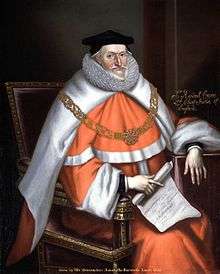
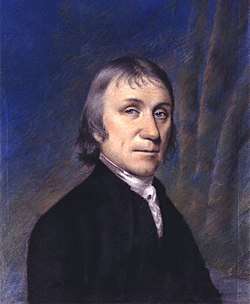
%2C_by_unknown_artist.jpg)

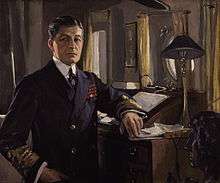
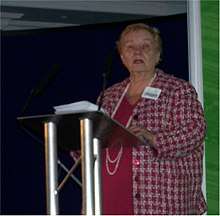

Early times
- Sir Nicholas Colfox (flourished 1400 and came from Nantwich), medieval knight, in 1397 was involved in the murder of Thomas of Woodstock, 1st Duke of Gloucester, uncle of King Richard II
- Blessed Thomas Holford (1541–1588), Protestant schoolteacher,[58] then a Catholic priest, martyred in Clerkenwell, beatified 1896
- Isabella Whitney (born 1545 in Coole Pilate – 1577), arguably the first female poet and professional woman writer in England, credited with being the first Englishwoman to have penned and published original secular poetry under her own name
- Geoffrey Whitney (c.1548 in Acton – c.1601), poet[59]
- Sir Roger Wilbraham (1553 in Nantwich – 1616), prominent English lawyer[60] and Solicitor-General for Ireland under Elizabeth I
- John Gerard (1545 in Nantwich – 1612), botanist[61] and author of Herball, or Generall Historie of Plantes (1597),[62]
- Sir Randolph Crewe (1559 in Nantwich – 1646),[63] Lord Chief Justice
- Briget Paget (1570 in Nantwich – c.1647), English Puritan, acted as her husband John Paget's literary executor and editor
- Sir William Brereton, 1st Baronet (1604–1661) established his headquarters[64] in Nantwich during the English Civil War in 1643
- Elizabeth Minshull (1630–1727), third wife[65] and widow of poet John Milton, born in Wistaston, lived as a widow in Nantwich and is buried at the Baptist Chapel in Barker Street
18th century
- The Reverend Joseph Partridge (1724–1796), waggoner,[66] antiquary and historian, author of the town's first history in 1774.
- Joseph Priestley (1733–1804), co-discoverer of oxygen,[67] Nonconformist minister and teacher, lived in Nantwich 1758–1761
- Roger Wilbraham FRS (1743 in Nantwich – 1829), MP,[68] bibliophile, antiquary, local historian, published work on Cheshire dialect
- Hanmer George Warrington (c.1776 in Acton – 1847), British Army officer then Consul General on the Barbary Coast for 32 years.
- Peter Bayley (1779 in Nantwich – 1823), writer[69] and poet
19th century
- George Latham (c.1800 in Nantwich – 1871), architect
- Eddowes Bowman (1810 in Nantwich – 1869), dissenting tutor[70]
- Henry Bowman (1814 in Nantwich – 1883), architect[71] in partnership with Joseph Crowther
- Sir William Bowman (1816 in Nantwich – 1892), surgeon,[72], histologist, anatomist, used microscopes, ophthalmologist
- Thomas Egerton Hale VC CB (1832 in Nantwich – 1909), recipient[73] of the Victoria Cross
- Thomas Bower (1838–1919), English architect and surveyor based in Nantwich
- James Hall (1846–1914), lived in the town for 40 years and wrote its history.[74]
- A.N. Hornby (1847–1925), first to captain England at both cricket and rugby, and England cricket captain when the Ashes series was created, is buried in Acton churchyard, Nantwich
- William Pickersgill (1861 in Nantwich – 1928), chief mechanical engineer[75] of the Caledonian Railway until Grouping in 1923
- Harry Stafford (1869–1940), footballer,[76] 271 professional appearances, later a hotelier in Canada.
- David Beatty, 1st Earl Beatty (1871 in Stapeley – 1936), Admiral of the Fleet
20th century
- Albert Thomas Price (1903 in Nantwich – 1978), geophysicist,[77] developed mathematical models on global electromagnetic induction.
- Robert Grant-Ferris, Baron Harvington (1907–1997), Deputy Speaker[78] of the House of Commons 1970–1974, was MP for Nantwich
- Sir Kenneth Mather CBE FRS (1911 in Nantwich – 1990) British geneticist and botanist
- Michael Winstanley, Baron Winstanley (1918–1993), Liberal MP[79] for Cheadle 1966 to 1970 and for Hazel Grove in 1974
- Gwyneth Dunwoody (1930–2008), British Labour Party politician,[80] MP for Exeter 1966/70, and then for Crewe (later Crewe and Nantwich) from 1974 to her death in 2008.
- Dario Gradi, (born 1941), manager[81] of Crewe Alexandra (1983–2007 and 2009–11), lives in Willaston
- Penny Jordan (1946–2011), best-selling[82] and prolific writer of over 200 romance novels
- Mike Wood (born 1946), Labour MP[83] for Batley and Spen 1997 to 2015, went to school in Nantwich
- John Dwyer (born c.1950), former police officer, borough councillor,[84] Assistant Chief Constable and Cheshire Police and Crime Commissioner
- Sir Andrew Witty (born 1964), CEO[85] of GlaxoSmithKline went to school in Nantwich
- Ben Miller (born 1966), actor,[86] director and comedian, grew up in Nantwich.
- Thea Gilmore (born 1979), singer/songwriter,[87] lives in Nantwich
- Ashley Westwood (born 1990 in Nantwich), footballer[88] with Crewe and Aston Villa F.C.
- Blitz Kids (active 2006–2015) were an English alternative rock band originating in Nantwich and Crewe.
See also
References
- ↑ "Neighbourhood Statistics". Neighbourhood.statistics.gov.uk. 14 April 2008.
- ↑ Cheshire Historic Towns Survey Nantwich Retrieved 24 December 2015.
- ↑ E.Ekwall, Concise Oxford Dictionary of Place-Names (Oxford) 1936:320 col. a.
- ↑ The Gough Map (interactive version) Archived 5 May 2008 at the Wayback Machine. (accessed 21 April 2008)
- ↑ "Holly Holy Day Society website". Hollyholyday.org.uk. Retrieved 21 September 2018.
- ↑ Lake, 1983, p. 1
- ↑ McNeil Sale R; et al. (1978), Archaeology in Nantwich: Crown Car Park Excavations, Bemrose Press
- ↑ Phillips & Phillips, eds, 2002, p. 32.
- 1 2 Hewitt, 1967, p. 67
- 1 2 Borough of Crewe & Nantwich: Nantwich Conservation Area: Conservation Area Character Appraisal and Review (January 2006).
- ↑ Lake, 1983, pp. 3, 30
- ↑ Lake, 1983, p. 67.
- ↑ Beck, pp. 34–35 and 75–76.
- ↑ Lake, 1983, pp. 76 and 91.
- ↑ Photo: Great Fire of Nantwich – plaque. Retrieved 9 December 2013.
- ↑ Battle of Nantwich... and Holly Holy Day Archived 31 May 2010 at the Wayback Machine., Nantwich Museum, UK.
- 1 2 Pevsner & Hubbard, 1971, p. 12.
- 1 2 Lake, 1983, pp. 131–32.
- ↑ Phillips & Phillips, eds, 2002, p. 66.
- ↑ Lake, 1983, pp. 30–31 and 35.
- 1 2 3 4 5 6 "A Long History, 17 September 2015". Nantwich Mill. Retrieved 23 December 2016.
- 1 2 3 4 5 6 Shaw, Mike; Clark, Jo (2002). Nantwich: Archaeological Assessment (PDF). Chester: Cheshire County Council. Retrieved 23 December 2016.
- ↑ "History". Ginger & Pickles. Retrieved 23 December 2016.
- ↑ Wilkes, Sue. "Nantwich: A Town That's Worth Its Salt". TimeTravel-Britain.com. Retrieved 23 December 2016.
- ↑ Thompson, James. "Exciting project for mill site". A Dabber's Nantwich. Retrieved 23 December 2016.
- ↑ Cheshire East Local Development Framework: Nantwich Snapshot Report (PDF). Sandbach: Cheshire East Council. 2011. p. 22. Retrieved 23 December 2016.
- ↑ Cheshire East Local Plan: Draft Nantwich Town Strategy Consultation. Sandbach: Cheshire East Council. 2012. p. 9. Retrieved 23 December 2016.
- ↑ "Nantwich Mill Hydro Generation". Companies House. Retrieved 23 December 2016.
- ↑ Hall, James (1883). A history of the town and parish of Nantwich, or Wich-Malbank, in the county palatine of Chester. Nantwich: Johnson.
- ↑ "Nantwich's famous outdoor Brine Pool re-opens this weekend". Nantwich News. 3 May 2018. Retrieved 15 August 2018.
- 1 2 3 4 Pearson, Bill. "Brine Baths Hotel". Bill Pearson's Home Page. Retrieved 4 January 2017.
- 1 2 "Built for a bride". A Dabber's Nantwich. Retrieved 4 January 2017.
- ↑ "Caption for Nantwich, Brine Baths Hotel 1898". Francis Frith. Retrieved 4 January 2017.
- ↑ Adams, Jane M. (2015). Healing with water: English spas and the water cure, 1840–1960. Manchester: Manchester University Press. ISBN 9780719098062.
- ↑ "About us: History". Nantwich Park Road Bowling Club. Archived from the original on 5 January 2017. Retrieved 4 January 2017.
- ↑ "WW1 Great War Centenary – Auxiliary Hospitals". Geograph. Geograph. Retrieved 4 January 2017.
- ↑ "The Cheshire (Structural Changes) Order 2008". Archived from the original on 17 May 2009.
- ↑ Cheshire County Council: Interactive Mapping: Crewe and Nantwich (accessed 27 January 2009)
- ↑ Take a Closer Look at Nantwich (booklet), Crewe & Nantwich Borough Council
- ↑ Borough of Crewe & Nantwich: Replacement Local Plan 2011: Insets: Nantwich Town Centre, Acton, Aston, Audlem, Bridgemere School, Buerton, Hankelow, Marbury, Sound School, Worleston School, Wrenbury , 4 June 2010)
- ↑ Hall, 1883, p. 255.
- ↑ Images of England: Dorfold Hall Accessed 21 February 2008.
- ↑ Pevsner, p. 22
- ↑ About Us, Nantwich Players Accessed 17 November 2010.
- ↑ Darroch, Gordon (18 February 2002). "Remote Highland highway 'most dangerous road'". The Independent. London. Retrieved 19 May 2010.
- ↑ "198 years and 153 meridians, 152 defunct" (PDF). Charlesclosesociety.org. Retrieved 21 September 2018.
- ↑ "The Weaver Stadium". Nantwich Town F.C. Retrieved 15 August 2018.
- ↑ "Archived copy". Archived from the original on 12 September 2011. Retrieved 10 May 2010.
- ↑
- ↑ "October 2017 newsletter" (PDF). Cheshire County Cricket League. Retrieved 10 November 2017.
- ↑ "The Dabber – Nantwich's own free newspaper". Thedabber.co.uk.
- ↑ "Home – International Cheese Awards". Internationalcheeseawards.co.uk.
- ↑ "Nantwich Show". Nantwichshow.co.uk.
- ↑ Worm Charming Championships Retrieve 15 August 2016.
- ↑ Hilton, Rhiannon (7 March 2016). "Nantwich Jazz, Blues and Music Festival celebrates 20th year". Crewechronicle.co.uk.
- ↑ "The 23rd Nantwich Jazz Blues & Music Festival". Nantwichjazz.com. Retrieved 21 September 2018.
- ↑ Own site Retrieved 24 July 2016.
- ↑ Nine Martyrs of the Shrewsbury Diocese retrieved January 2018
- ↑ Dictionary of National Biography, 1885–1900, Volume 61, Whitney, Geoffrey retrieved January 2018
- ↑ The History of Parliament Trust, WILBRAHAM, Sir Roger (1553–1616) retrieved January 2018
- ↑ Jackson, Benjamin Daydon. "Gerard John (1545-1612)". Retrieved 21 September 2018 – via Wikisource.
- ↑ ODNB: Marja Smolenaars, "Gerard, John (c.1545–1612)" Retrieved 22 April 2014.
- ↑ Rigg, James McMullen. "Crew Ranulphe". Retrieved 21 September 2018 – via Wikisource.
- ↑ The History of Parliament Trust, BRERETON, Sir William, 1st Bt. (1604–1661) retrieved January 2018
- ↑ "Elizabeth Milton". Geni_family_tree. Retrieved 21 September 2018.
- ↑ Dictionary of National Biography, 1885–1900, Volume 43, Partridge, Joseph retrieved January 2018
- ↑ 1911 Encyclopædia Britannica, Volume 22, Priestley, Joseph retrieved January 2018
- ↑ The History of Parliament Trust, WILBRAHAM, Roger (1743–1829) retrieved January 2018
- ↑ Dictionary of National Biography, 1885–1900, Volume 03, Bayley, Peter retrieved January 2018
- ↑ Dictionary of National Biography, 1885–1900, Volume 06, Bowman, Eddowes retrieved January 2018
- ↑ Dictionary of National Biography, 1885–1900, Volume 06, Bowman, John Eddowes (1785–1841) & Henry Bowman (1814–1883) retrieved January 2018
- ↑ Dictionary of National Biography, 1901 supplement, Bowman, William retrieved January 2018
- ↑ Obituary in the British Medical Journal, 1910 Jan 1, Surgeon-Major Thomas Egerton Hale, V.C., C.B., M.D retrieved January 2018
- ↑ Nantwich Museum: James Hall Archived 13 October 2012 at the Wayback Machine. (accessed 3 April 2013)
- ↑ "William Pickersgill". Steamindex.com. Retrieved 21 September 2018.
- ↑ "Harry Stafford". MUFCInfo.com. Archived from the original on 13 February 2018. Retrieved 21 September 2018.
- ↑ "1979QJRAS..20..328 Page 328". Adsabs.harvard.edu. Retrieved 21 September 2018.
- ↑ "THE HOUSE OF COMMONS CONSTITUENCIES BEGINNING WITH "N"". Leighrayment.com. Retrieved 21 September 2018.
- ↑ "Obituary: Lord Winstanley". Retrieved 21 September 2018.
- ↑ "Gwyneth Dunwoody, former MP, Crewe and Nantwich - TheyWorkForYou". TheyWorkForYou. Retrieved 21 September 2018.
- ↑ "Dario Gradi - Latest Betting Odds - Soccer Base". Soccerbase.com. Retrieved 21 September 2018.
- ↑ "Penny Jordan, author of 200 romance novels, dies at 65". Washington Post. Retrieved 21 September 2018.
- ↑ "Mike Wood, former MP, Batley and Spen - TheyWorkForYou". TheyWorkForYou. Retrieved 21 September 2018.
- ↑ "Conservative man Dwyer named as Cheshire's first police commissioner". Winsford Guardian. Retrieved 21 September 2018.
- ↑ "City interview: Glaxo's Andrew Witty". Retrieved 21 September 2018.
- ↑ "Ben Miller". IMDb. Retrieved 21 September 2018.
- ↑ "Thea Gilmore". Discogs. Retrieved 21 September 2018.
- ↑ "Ashley R Westwood - Football Stats - Burnley - Age 28 - Soccer Base". Soccerbase.com. Retrieved 21 September 2018.
Bibliography
External links
| Wikimedia Commons has media related to Nantwich. |
| Wikivoyage has a travel guide for Nantwich. |

- Social guide to Nantwich
- Cheshire East Council
- Nantwich Web Directory
- Nantwich history
- Cheshire Market Towns
